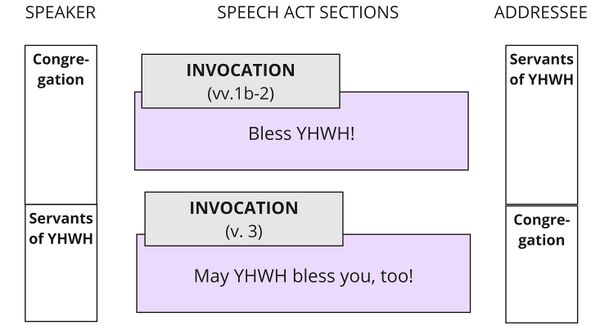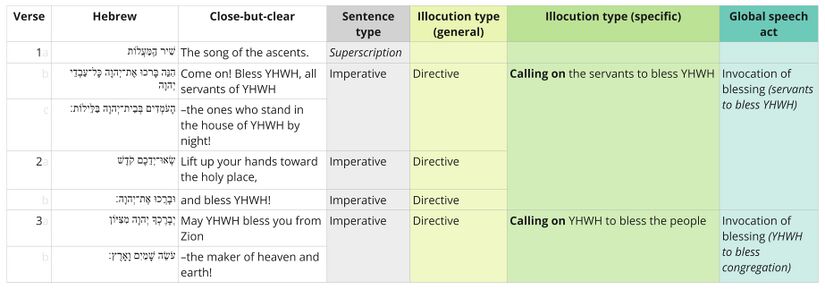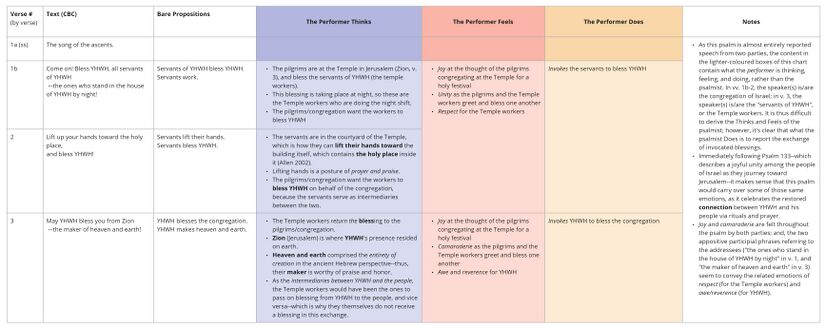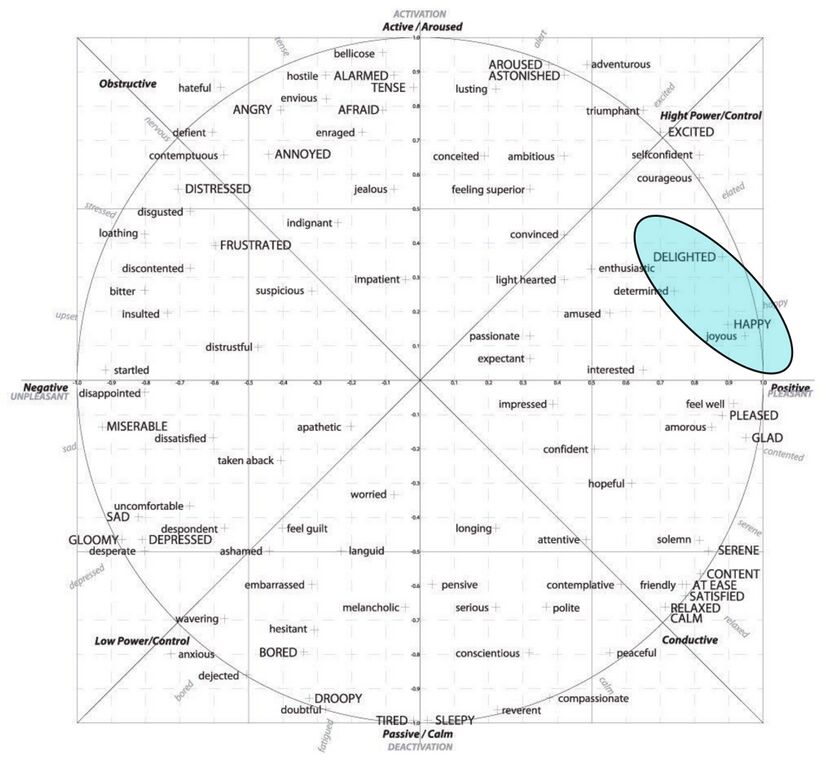Psalm 134 Discourse
About the Discourse Layer
Our Discourse layer includes four analyses: macrosyntax, speech act analysis, emotional analysis, and participant analysis. (For more information, click 'Expand' to the right.)
Macrosyntax
The macrosyntax layer rests on the belief that human communicators desire their addressees to receive a coherent picture of their message and will cooperatively provide clues to lead the addressee into a correct understanding. So, in the case of macrosyntax of the Psalms, the psalmist has explicitly left syntactic clues for the reader regarding the discourse structure of the entire psalm. Here we aim to account for the function of these elements, including the identification of conjunctions which either coordinate or subordinate entire clauses (as the analysis of coordinated individual phrases is carried out at the phrase-level semantics layer), vocatives, other discourse markers, direct speech, and clausal word order.
For a detailed explanation of our method, see the Macrosyntax Creator Guidelines.
Speech Act Analysis
The Speech Act layer presents the text in terms of what it does, following the findings of Speech Act Theory. It builds on the recognition that there is more to communication than the exchange of propositions. Speech act analysis is particularly important when communicating cross-culturally, and lack of understanding can lead to serious misunderstandings, since the ways languages and cultures perform speech acts varies widely.
For a detailed explanation of our method, see the Speech Act Analysis Creator Guidelines.
Emotional Analysis
This layer explores the emotional dimension of the biblical text and seeks to uncover the clues within the text itself that are part of the communicative intent of its author. The goal of this analysis is to chart the basic emotional tone and/or progression of the psalm.
For a detailed explanation of our method, see the Emotional Analysis Creator Guidelines.
Participant Analysis
Participant Analysis focuses on the characters in the psalm and asks, “Who are the main participants (or characters) in this psalm, and what are they saying or doing? It is often helpful for understanding literary structure, speaker identification, etc.
For a detailed explanation of our method, see the Participant Analysis Creator Guidelines.
Discourse Visuals for Psalm 134
Macrosyntax
Notes
Paragraph Divisions
- 1a is set off from the rest of the psalm due to the fact that it is a superscription, as well as 1b beginning with the emphatic particle הִנֵּה, which "directs attention to an attractive phenomenon, here to a duty which springs from the office [of priesthood]" (Keil & Delitzsch 1996)--the duty, marked with an imperative, being to bless YHWH on behalf of the people of Israel. For more about this construction, see our Exegetical Issue.
Vocatives
- The vocative "all servants of YHWH–the ones who stand in the house of YHWH by night!" might be serving to focus the content of the following phrase, "the ones who stand in the house of YHWH by night", as per one of the common functions of vocatives in this position (Kim 2022: 235-237). This focus on the servants is supported by several modern translations' titling of this psalm, such as "Exhortation to the Temple guardians" (NVR95), "Greetings of night watchers" (NASB).
Speech Act Analysis
Summary Visual
Speech Act Chart
Emotional Analysis
Summary visual
Emotional Analysis Chart
Circumplex
Participant analysis
There are 3 participants/characters in Psalm 134:
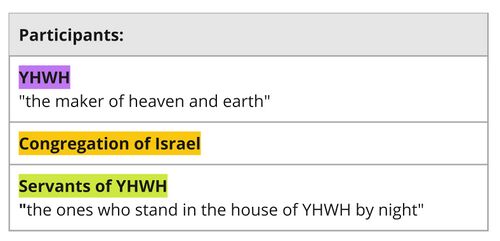
- YHWH: Though not directly addressed in this psalm, YHWH is mentioned five times--first as the recipient of service and blessing in vv. 1b-2, then as the source of blessing in v. 3. Also in v. 3, he is called "the maker of heaven and earth"--a reminder that though he is present with his people at earthly Zion, he has authority over all creation and is worthy to be blessed.
- Congregation of Israel: This is the group of the pilgrims, the people of Israel, who have journeyed up to Jerusalem and gathered at the Temple for an annual holy festival.
- Servants of YHWH: The vocative, "all servants of YHWH" is ambiguous; some scholars believe it references the whole congregation who has gathered at the Temple, rather than the priests/Levites/Temple workers (who are working "by night" (v. 1c). See our analysis of this issue here. In short, it is probably the priests/Levites/Temple workers rather than the congregation.
Participant Relations Diagram
The relationships among the participants may be abstracted and summarized as follows:
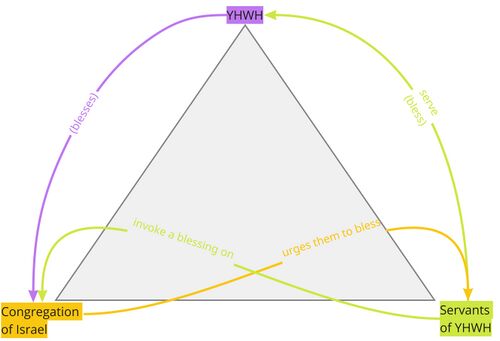
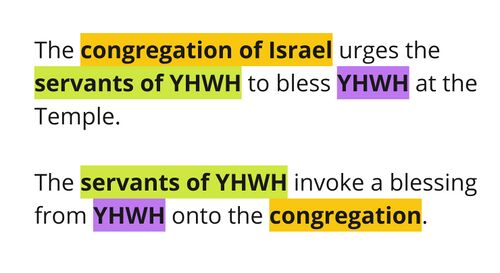
Participant Analysis Table
Notes
- You'll note that the servants do not themselves receive a blessing in this exchange. This might be because they served as intermediaries between the people and YHWH, so in this situation, they are passing on blessings between the two parties, without themselves being blessed. It's also possible that as YHWH blesses the congregation of Israel, the servants are included in that group.
- v. 3: "you"
- If the congregation of Israel is composed of many people, why is the 2nd person masculine singular pronoun suffix -ךָ used in this address? The singular pronoun may be referring to the congregation as a whole, or perhaps directed at each individual in the congregation. (Kirkpatrick 1906). The pronoun could be considered a stereotyped element--a common device in the Hebrew Bible, which can be exemplified by the use of the singular you in the Aaronic blessing in Num. 6:24-26 (Allen 2002). The suffix is used generically and not intended to be directed at any one person.

